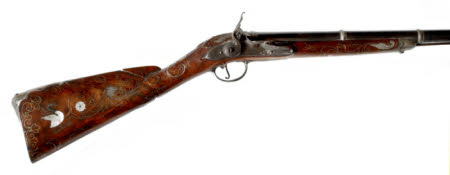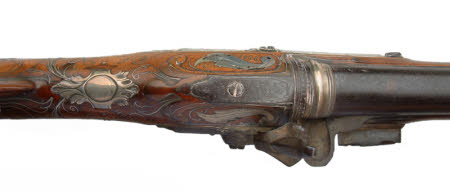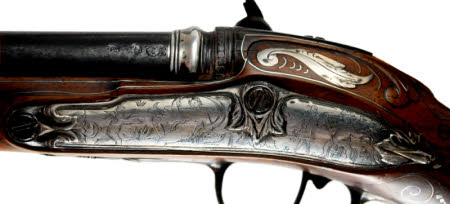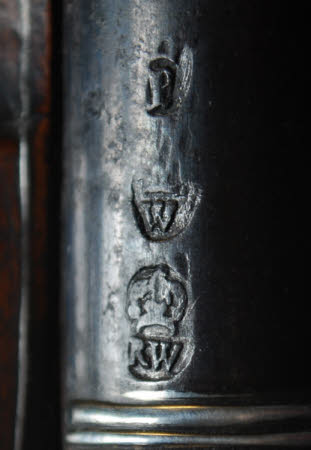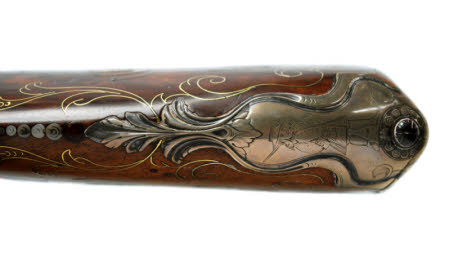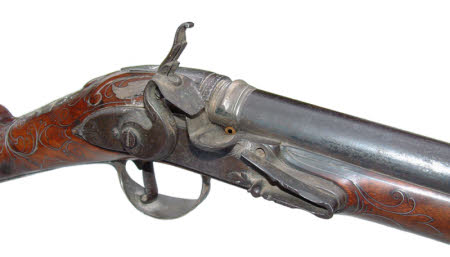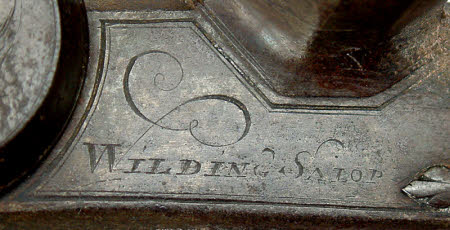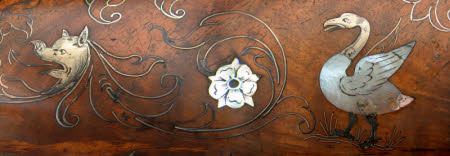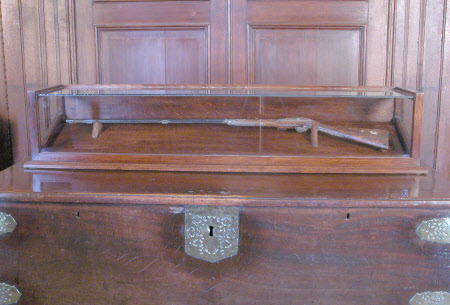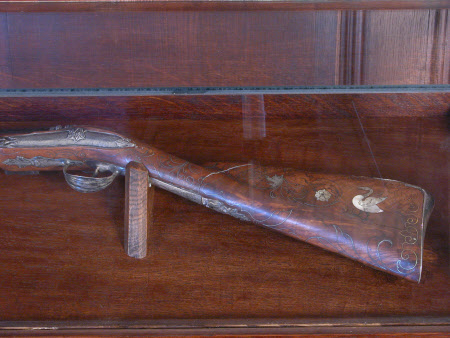Flintlock gun
Richard Wilding Snr (c.1650 - c.1715)
Category
Arms and armour
Date
circa 1715
Materials
iron, walnut, brass, silver and mother-of-pearl
Measurements
136.6 cm (length)
Place of origin
Shrewsbury
Order this imageCollection
Dudmaston, Shropshire
NT 814001
Summary
Silver mounted flintlock sporting gun by Richard Wilding of Shrewsbury c1715.
Full description
A rare and fine quality flintlock sporting gun by R. Wilding, Salop, c1715-20. Richard Wilding Senior (c1650 - c1715) and Richard Wilding Junior (1678 - 1755) are both recorded as gunsmiths working in Shrewsbury, Salop. The gun far exceeds the normal quality expected of a provincial fowling piece of the early 1700s. Despite some damage and losses, the gun, with its magnificent inlays to the stock, consisting of silver and mother of pearl, still retains enough of its former glory to show that this is an important provincial piece. It is reputed to have belonged to Colonel Thomas Weld (1678 – 1774) who served in the Duke of Marlborough’s campaigns during the early years of the 18th century. Thomas Weld was the brother-in-law of Thomas Wolryche who had the present Dudmaston Hall built during the late 1600s. When the Wolrych line died out in 1771, Thomas Weld inherited Dudmaston from his sister Elizabeth Wolryche . The gun has remained at the house ever since. The figured walnut stock is decorated in a spectacular style, being profusely inlaid overall with silver wire scrolls, and also with shaped and engraved silver plaques on the fore-stock and behind the breech The butt incorporates three inlaid motifs on each side. These depicts a swan, with the body composed of mother of pearl and the feet and head of silver, a rose, also in mother of pearl, and finally, an animal head (perhaps a boar?) in silver. The wood at the rear of the barrel has a carved decoration which is enhanced with silver wire and inlaid leafy panels of silver. The lock is constructed in a form fashionable in England during the early years of the 18th century, with chiselled decoration and is engraved in script, Wilding, Salop. The barrel is formed with three substantial silver rings at the breech and has a gold lined touch-hole which is unusual for this early period. The left side of the breech is stamped with two unidentified proof marks, a crowned P and a W (which may be Wilding’s own proof marks and perhaps one of the earliest known English provincial proof marks) together with his makers mark, RW under a crown. Along the top of the barrel, towards the breech, is a Latinised signature, R. Wilding de Salop engraved in script. The gun follows a fashion similar to that of continental sporting guns of the same period, although English examples from the early 18th century are now very rare. One, by William Mills of London and dated 1721, is now in the collection of the Royal Armouries at the Tower of London (XII.1789). Only a few examples of the Wildings’ work are known and most can be dated to the period of Richard Wilding Junior. Whether the same can be said for the magnificent silver mounted sporting gun at Dudmaston will probably never be known. It is tempting to think that both Richard Wilding, Senior (c1650-c1715) and Junior (1678-1755) may have collaborated on it and if this is so, it is a very fine tribute to two previously unknown English gunmakers. Summary Description Round tapering iron barrel with 3 tranverse silver mouldings, and made with a false breech. The breech stamped with 2 private proof marks, a crowned P and crowned V, together with a makers mark (RW under a Crown). The top of the barrel is engraved in script, R. WILDING DE SALOP. The barrel tang is engraved with a crested bird. The central moulded silver barrel ring has a V-shaped sighting grove. There is a gold lined touch-hole. The false breech is decorated with turned mouldings and chiselling where it meets the barrel. The muzzle has a silver blade foresight and a silver ramp to secure the ramrod is soldered to the underside. Also 2 silver baluster turned ramrod pipes are soldered to the underside of barrel. The barrel is secured to the stock by a single screw at the fore-end cap. The steel ramrod is a modern (and incorrect) replacement. Barrel length 98cm. Calibre 17 mm. Half-stock of finely figured walnut profusely inlaid with silver and some brass (or gold?) wire in a design of scrolls and foliage; also inlaid with plaques of cut and engraved silver and mother of pearl depicting a swan, a hogs-head and a rose. There is a lightly carved apron around the barrel tang. The engraved and chiselled silver furniture comprises; a bulbous buttplate, the upper tang formed with a chased finial and engraved with an early 18th century figure (a man holding a gun), the flat of the plate with a hidden trap and its lid engraved with an Heraldic crest; the trigger guard with a long rear tang engraved with a serpent and an acanthus form finial; the large sideplate engraved with a Bacchus scene, the rear with chased decoration; the leafy form escutcheon plate with traces of an engraved crest (worn); the fore-end cap engraved and chased in a similar style. Iron trigger with a scroll form tip. The flintlock has a plate of thick, flat form with bevelled edges and has a raised chiselled decoration at the tail. The plate and cock are engraved and it is signed below the pan in script, WILDING, SALOP. The cock jaw and the pan are of facetted form, the latter decorated with a chiselled edge. The frizzen spring has a chiselled edge and a decorative finial. The frizzen and its securing screw are missing and the top-jaw and part of jaw-screw are also missing. Internally the lock is complete and was originally polished bright, the lock component screws still retaining their blued finish. Overall length: 136.6 cm. References Brian Godwin, “Wilding, Salop – Gunmakers”, Classic Arms & Militaria Magazine, Vol.XV1, Issue 5, 2009 Brian Godwin, “Wilding, Salop – Gunmakers”, Journal of the Arms & Armour Society, London, March 2011 Brian Godwin, “Wilding, Salop – Gunmakers”, Arts, Buildings & Collections Bulletin (ABC), 2011 (available online)
Provenance
Dudmaston collection; originally owned by Colonel Thomas Weld (uncle of Mary Wolryche), who served throughout Marlborough's campaigns and inherited Dudmaston from his sister, Mary Wolryche in 1771.
Marks and inscriptions
Barrel top: R Wilding de Salop Barrel breech - left: Crowned P and Crowned V proof marks Lockplate: R Wilding
Makers and roles
Richard Wilding Snr (c.1650 - c.1715), gunsmith Richard Wilding Jnr (1678 - 1755), gunsmith
